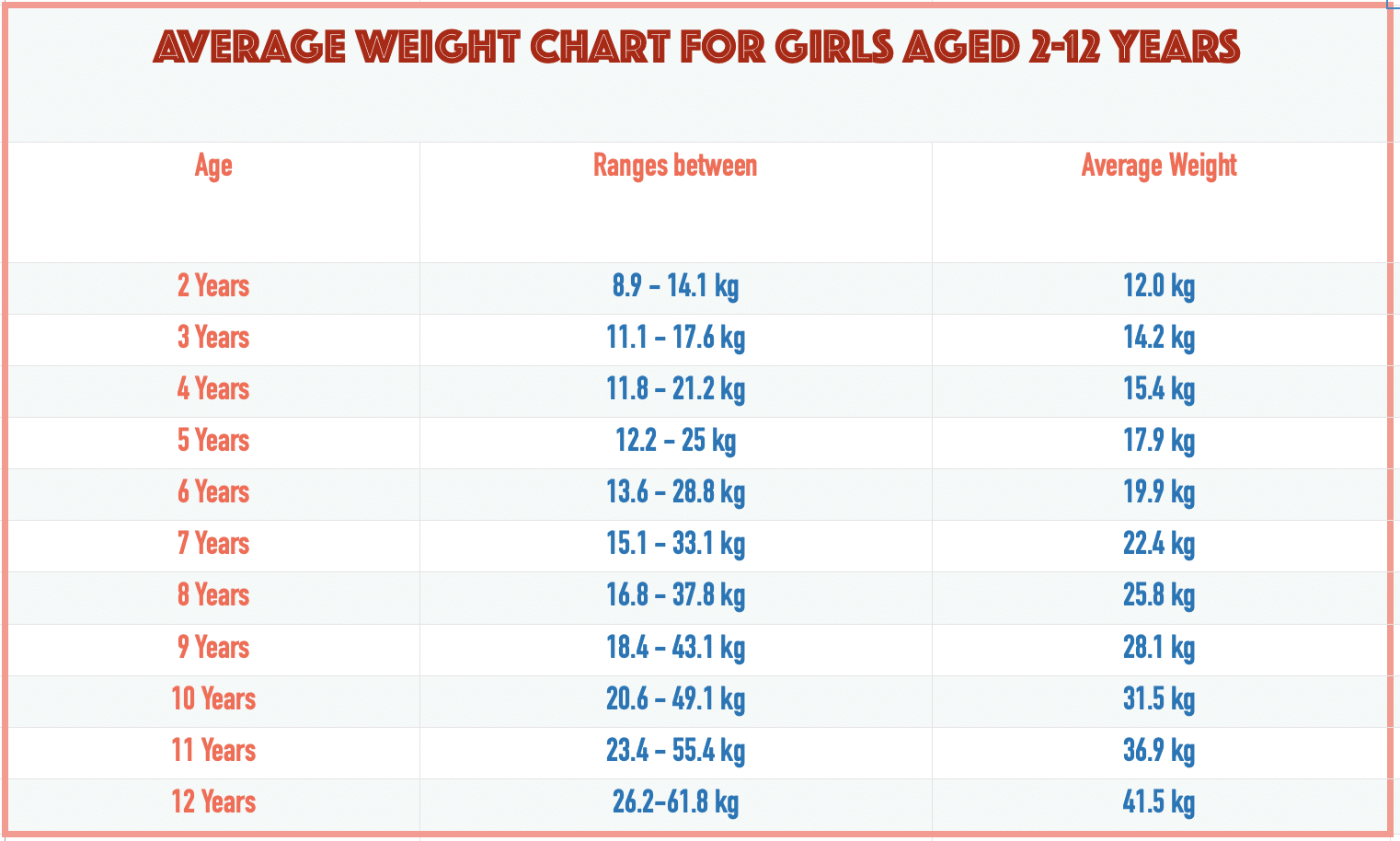In the journey of a young adolescent’s development, it is crucial to determine whether they maintain a healthy weight. The concept of ‘average weight’ varies between genders, and several factors influence it, extending beyond biological sex. We delve into these averages, their determinants, and potential health risks related to deviations from the norm, backed by insights from the Centers for Disease Control and Prevention (CDC).
How Much Should My 12-Year-Old Weigh?

Females
According to the CDC, the average weight of a 12-year-old female is 92 pounds (lb), which translates to approximately 42 kilograms (kg). These figures, however, only scratch the surface. Let’s explore this in more detail by percentile:
| Percentile Range | Weight (lb) | Weight (kg) |
|---|---|---|
| 10th – 90th | 80 – 103 | 36 – 47 |
| 3rd – 97th | 75 – 108 | 34 – 49 |
| 1st – 99th | 73 – 112 | 33 – 51 |
Males

For 12-year-old males, the CDC reports an average weight of 89 lb, which corresponds to approximately 40 kg. This data becomes more meaningful when examined across percentiles:
| Percentile Range | Weight (lb) | Weight (kg) |
|---|---|---|
| 10th – 90th | 76 – 100 | 34 – 45 |
| 3rd – 97th | 71 – 106 | 32 – 48 |
| 1st – 99th | 68 – 110 | 31 – 50 |
Also read: what is the average weight for a 13 year old
Indicators of Concern
A healthcare provider may raise concerns if a young adolescent’s weight falls within the 3rd percentile or deviates significantly from the CDC’s growth chart. Sudden, drastic weight changes can also trigger alarm bells.
The Complexities of Low Weight
When a child exhibits below-average weight, healthcare professionals may employ the term “failure to thrive.” Several factors can contribute to this condition, even in older children. These potential causes include:
- Premature birth
- Down syndrome
- Metabolic disorders
- Cystic fibrosis
- Food allergies or intolerances
- Gastroesophageal reflux
- Stress (home or school-related)
- Financial difficulties
Children with very low weight might experience developmental delays, thinking difficulties, behavioral issues, school-related problems, and below-average height.
Navigating the Challenges of High Weight
Conversely, children and young adolescents with overweight or obesity may face a range of health risks, such as:
- High cholesterol levels
- High blood pressure
- Impaired glucose tolerance, insulin resistance, or type 2 diabetes
- Breathing difficulties (asthma or sleep apnea)
- Joint issues
- Heartburn
- Gallstones
- Fatty liver disease
- Depression
- Anxiety
- Low self-esteem
According to the CDC, children with obesity are more likely to carry these risks into adulthood.
Factors Influencing Weight Variation in 12-Year-Olds
Rate of Development
The onset of puberty plays a vital role in a child’s weight fluctuations. Puberty can begin as early as age 8 or as late as 14, causing rapid changes in height, muscle mass, and fat deposits. Thus, some 12-year-olds may have already undergone these transformations, while others are only beginning their journey.
Height and Body Makeup
A child’s height is an influential factor in determining their weight. Taller kids may naturally weigh more than their shorter peers, although it’s important to note that this isn’t a strict rule. Body shape, muscle mass, and frame size are also pivotal in assessing weight. For instance, a physically active child with more muscle than fat might weigh more due to muscle density.
Genetics
Genetics are a fundamental contributor to a child’s height, body mass, and other physical attributes. Regardless of dietary and exercise habits, genetics play a significant role in determining a child’s weight.
Location
Geographical location can also affect a child’s weight due to variations in the onset of puberty. For example, in northern Europe, puberty often starts earlier than in southern Europe. This divergence can be attributed to factors like obesity rates, genetics, and cultural practices.
BMI as a Holistic Indicator
To assess a young adolescent’s weight comprehensively, healthcare providers often calculate their Body Mass Index (BMI). This measurement considers both weight and height, providing a more accurate reflection of their overall health. The CDC offers a BMI calculator for children aged 2-18 years, requiring input on weight (in pounds), height (in inches), and age (in months or years and months). The calculator not only yields the BMI but also places it in percentile context, offering more detailed information.

The Influential Factors
Several factors can significantly influence the weight of a 12-year-old:
Height
Height is a paramount determinant; shorter individuals tend to weigh less than their taller counterparts. This interplay is captured by BMI calculators.
Puberty Onset
Puberty, a transformative phase in adolescence, leads to growth spurts and other physical changes that impact weight. While estimations suggest that males enter puberty between 9.5 and 14 and females between 8 and 13, actual onsets may vary significantly.
Genetics
Genetic factors may render some individuals more susceptible to obesity. Nevertheless, it’s vital to remember that diet and exercise remain essential contributors to a person’s weight.
Body Composition
In assessing weight, it’s essential to consider body composition. A child with a higher-than-average body fat percentage may weigh more, as may an active child with significant muscle tone. Muscle, denser than fat, can skew weight.
Environmental Factors
A child’s weight can be markedly influenced by environmental factors, including:
- Consuming high-calorie, processed foods
- Leading a sedentary lifestyle
- Coping with high stress levels
- Experiencing insufficient sleep
Illnesses
Certain health conditions can contribute to weight fluctuations in children and adolescents. For instance, conditions such as depression, hypothyroidism, polycystic ovary syndrome (PCOS), and Cushing’s disease can lead to weight gain, while others, like depression, eating disorders, hyperthyroidism, diabetes, Addison’s disease, and various gastrointestinal disorders, can result in weight loss.
Why Understanding Weight Matters
Understanding your child’s weight is crucial for several reasons. A BMI in the overweight or obese range can increase the risk of health issues such as type 2 diabetes, high cholesterol, or high blood pressure. Additionally, children who are overweight are more likely to carry this into adulthood. By using this information, you can collaborate with your child’s physician to guide your child towards achieving and maintaining a healthy weight.
Navigating Puberty with Your Child
Puberty can be a challenging and emotional time for children as their bodies and hormones undergo dramatic changes. To help them navigate this period effectively, consider the following:
Explaining Puberty
Sit down with your child and explain what puberty is and what it means in terms of physical and emotional changes. Assure them that these changes are normal and part of growing up.
Embracing Diversity
Encourage your child to understand that people come in different shapes and sizes, and there’s no universal standard of beauty. Ask them to create a list of things they appreciate about themselves, both physically and otherwise.
Media Influence
Discuss how images in the media can create unrealistic ideals for body types. Emphasize that not everyone should aspire to these standards, as health and beauty are diverse.
Positive Self-Esteem
Model positive behaviors by talking about the attributes you appreciate in yourself and your child that go beyond physical appearance. This sets an excellent example for your child.
Timeline Variability
Remind your child that everyone experiences puberty at their own pace. Some start earlier, while others start later. Reiterate that there is no set timetable for these changes.
Open Communication
Make it clear to your child that you are available to discuss any questions or concerns they might have. Maintaining open lines of communication is essential during this period of change.
Balanced Diet and Nutrition
Promoting a balanced diet is vital for healthy growth and development in children. Regardless of their weight, focus on offering whole foods, including fruits, vegetables, whole grains, low-fat dairy, lean protein, and healthy fats. Encourage mindful eating and listening to the body’s cues for hunger and fullness. Educate your child about portion sizes and the importance of avoiding distractions while eating. Ensure they do not skip meals and receive enough calories to fuel their growth.
In Summary
The average weight of a 12-year-old, standing at 92 lb for females and 89 lb for males, is a general benchmark. However, the true gauge of a young adolescent’s health lies in factors like height, body composition, and puberty onset. Deviations from the average weight can entail various health complications, emphasizing the importance of consultation with a pediatrician for any concerns.
Frequently Asked Questions
1. What does the percentile range in weight measurement signify?
- The percentile range indicates where a child’s weight falls concerning others of the same age and sex. For instance, a child in the 35th percentile weighs more than 35% of their peers but less than 65%.
2. How can I calculate my child’s BMI?
- To calculate your child’s BMI, you’ll need their weight (in pounds), height (in inches), and age (in months or years and months). The CDC offers a helpful BMI calculator for children aged 2-18.
3. What role does puberty play in a 12-year-old’s weight?
- Puberty introduces growth spurts and physical changes that can lead to weight fluctuations. While estimates for puberty onset exist, actual timings can vary widely.
4. Can genetics alone determine a child’s weight?
- Genetics may predispose individuals to obesity, but diet and exercise play pivotal roles in weight management.
5. How do environmental factors influence a child’s weight?
- Environmental factors, such as diet, lifestyle, stress levels, and sleep patterns, can significantly affect a child’s weight.
6. What health conditions can lead to weight gain in children?
- Conditions like depression, hypothyroidism, PCOS, and Cushing’s disease can contribute to weight gain in children and adolescents.
7. Are there health conditions that lead to weight loss in children?
- Health conditions like depression, eating disorders, hyperthyroidism, diabetes, and various gastrointestinal disorders can result in weight loss.
8. When should I consult a pediatrician regarding my child’s weight?
- If you observe your child’s weight falling significantly below or above the average, or if you have concerns about their weight, it’s advisable to consult a pediatrician.
9. How can I determine if my child has a healthy weight?
- To assess your child’s weight holistically, consider factors like height, body composition, and puberty onset. Consult with a healthcare provider for a more comprehensive evaluation.
10. What’s the significance of percentiles in weight measurement?
- Percentiles help contextualize a child’s weight by indicating where it stands in comparison to others of the same age and sex. It’s a valuable reference for assessing a child’s growth.
Remember that a child’s weight is only one aspect of their overall health, and consultation with a healthcare professional is key for accurate assessment and guidance.
